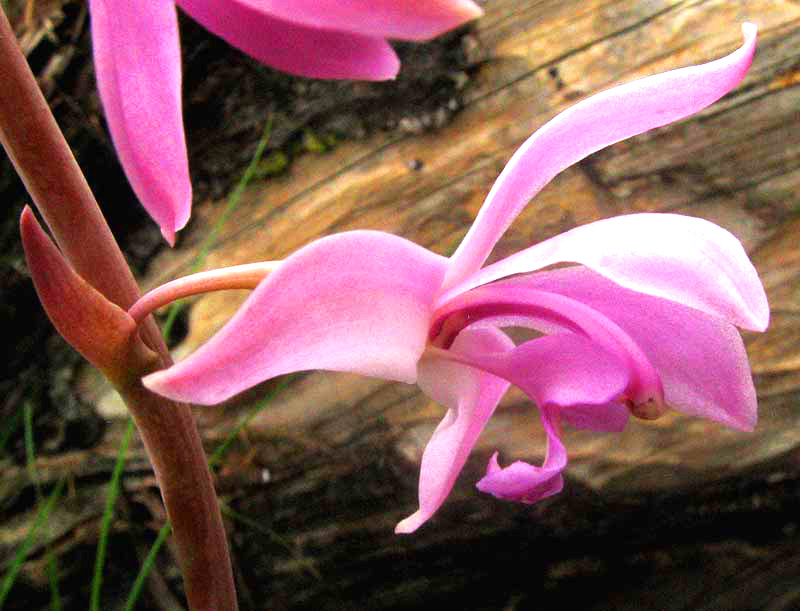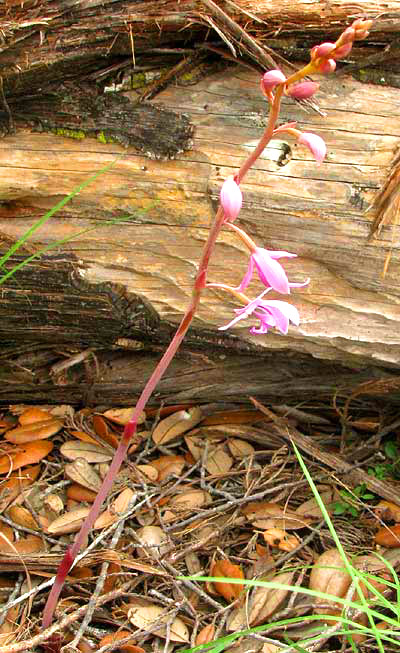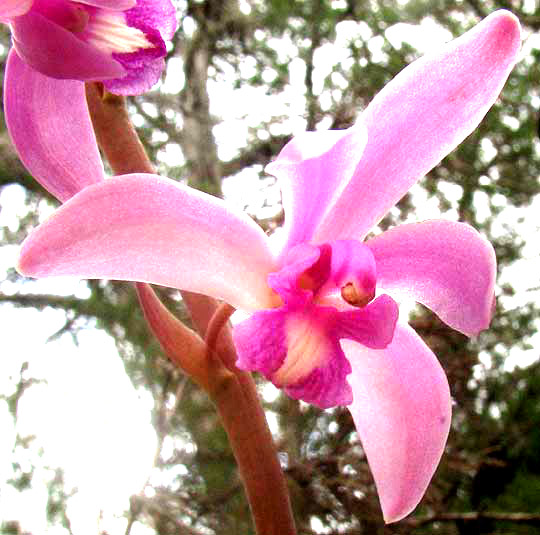Excerpts from Jim Conrad's
Naturalist Newsletter

from the June 22, 2014 Newsletter issued from the Frio Canyon Nature Education Center in the valley of the Dry Frio River in northern Uvalde County, southwestern Texas, on the southern border of the Edwards Plateau; elevation ~1750m (~5750 ft); N29.62°, W99.86°; USA
LARGEFLOWER CRESTED CORALROOT
This week, right below Juniper House, a flowering plant turned up that might qualify as the most interesting wildflower discovery made during my time here. It's something I've seen nowhere else, and which any botanist familiar with the Texas flora would get excited about. You can see it in all its 15-inch-high splendor (38cm) below:

It's an orchid unlike anything listed for this part of the Edwards Plateau, and I was flabbergasted to see it right at Juniper House's doorstep. Note that no leaf is associated with the flowering stem. Each blossom is associated with a small, triangular "bract" arising where the flower attaches to the stem, but these are not leaves. This is one of that small minority of orchid types that produce no leaves at all, and no chlorophyll, because it's saprophytic, meaning that it obtains food from dead organic matter, made possible by the orchid's symbiotic relationship with a fungus. This orchid doesn't photosynthesize its food like the vast majority of flowering plants.
A flower close-up appears at the top of this page.
Along with the Composite or Daisy Family, the Orchid Family is one of the two largest of all flowering plants. Though most orchid species occur in the tropics, the Flora of North America treats 208 orchid species in 70 genera occurring in North America.
During our orchid's identification process, the lack of leaves and chlorophyll eliminates the vast majority of candidate species our orchid could be. The flower disqualifies quite a few other possibilities simply by being so large -- about 1.5 inches (4cm) -- pink, and by not bearing a "spur." A flower's spur is a conical appendage projecting backward, and containing nectar for enticing pollinators to visit. Below, a shot of a flower from the front shows other field marks enabling us to identify the plant with certainty:

Important to notice here is that the darker-pink lower part, the "lip," is deeply three-lobed, with a pale center, and the low ridges running through the white zone are not colored, but rather are white.
So, our orchid is known variously as the Largeflower Crested Coralroot, Giant Coralroot, and by other names. It's HEXALECTRIS GRANDIFLORA*, found from southern Mexico to the north, but in the US, according to the Flora of North America found only in far western Texas, in the Big Bend area -- in the Davis and Chisos Mountains. In other words, this orchid is not supposed to be here...
I sent our photos to Dr. Tom Wendt, Curator of the Herbarium at The University of Texas at Austin, who confirmed the ID, and remarked that this is "a really great and interesting find." And despite what the Flora of North America says, Dr. Wendt also mentions two other fairly recent discoveries of the species outside the Big Bend area, near Austin and Dallas. "Your find helps fill in the huge gap between those two localities and the Trans-Pecos," he says, the Trans-Pecos being the region in Texas west of the Pecos River -- Big Bend.
Dr. Wendt isn't sure why suddenly the species is showing up far beyond its historically known boundaries. One thought is that maybe now that fewer livestock are roaming the hills eating everything in sight, orchids may be returning. One problem with that idea is that in our area we have a gross overpopulation of deer who also eat orchids.
Dr. Wendt wanted a voucher specimen but was sensitive to the problem of collecting the only plant known to exist in the region, so he asked for a single flower, pressed and dried, which has been provided. Eventually the Flora of North America may have the proof it needs to update its distribution information for the beautiful, mostly tropical Hexalectris grandiflora.